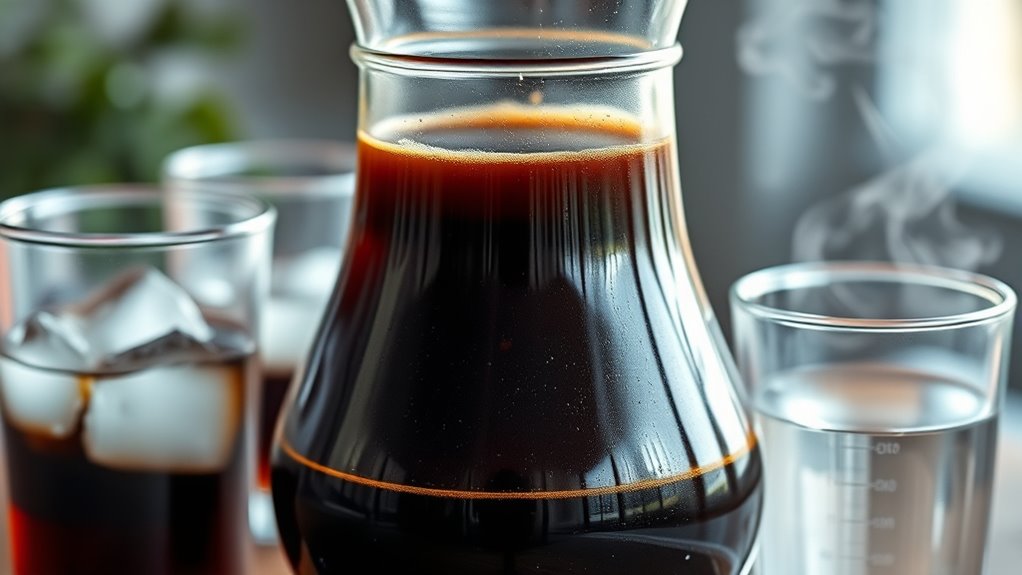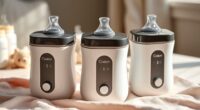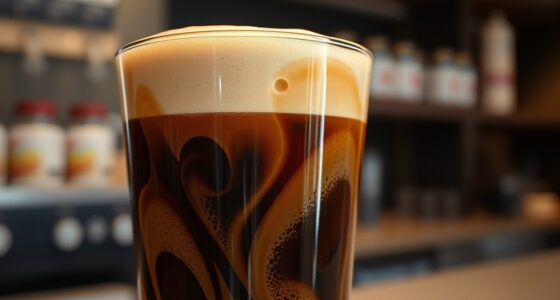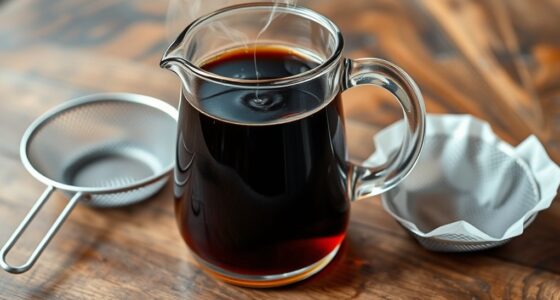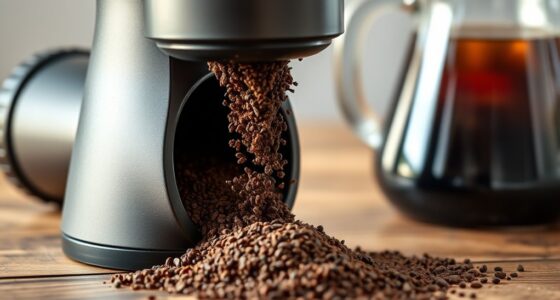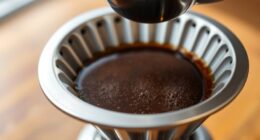When you use colder water for cold brew, the extraction process slows down, resulting in a milder, less acidic flavor and a lighter body. Warmer water speeds up extraction, allowing more flavors to develop quickly but increasing the risk of over-extraction and bitterness. Adjusting the temperature helps control how strong and complex your brew becomes. If you want to understand how to fine-tune your cold brew, this guide offers more detailed insights.
Key Takeaways
- Lower water temperatures slow extraction, resulting in milder, less acidic cold brew with delicate flavors.
- Warmer water speeds up extraction, producing a stronger, more robust flavor in a shorter time.
- Cold water requires longer steeping times (12-24 hours) to develop full flavor profile.
- Higher temperatures risk over-extraction, leading to bitterness or astringency if not carefully controlled.
- Adjusting water temperature allows for customization of strength, flavor, and complexity of the cold brew.
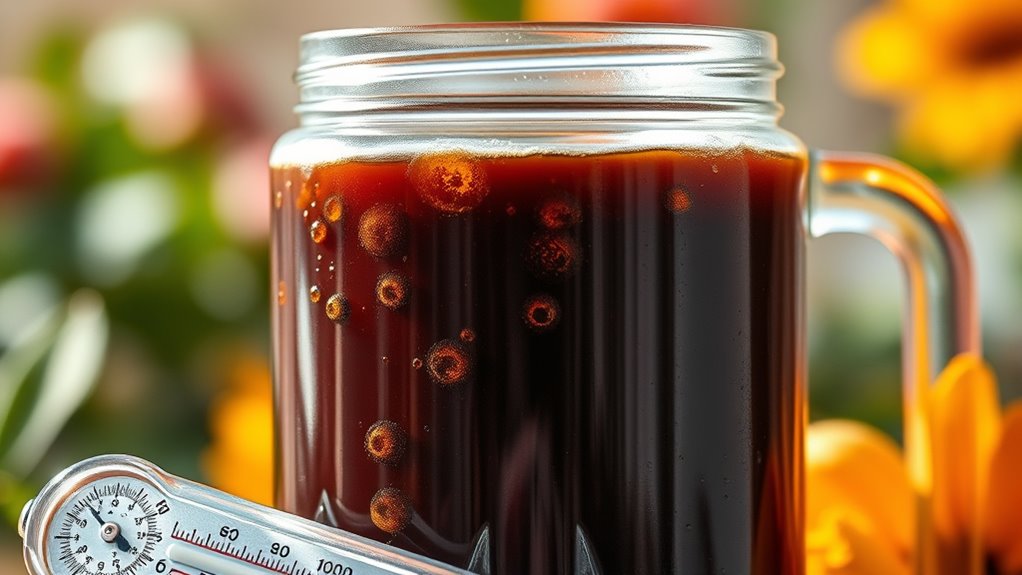
Water temperature plays a fundamental role in cold brew extraction, influencing the flavor, strength, and overall quality of your coffee. Even though cold brew is typically associated with cold or room temperature water, the temperature you choose directly impacts how the coffee’s compounds dissolve and develop. When you adjust the water temperature, you’re effectively controlling the brew strength and extraction time, which are essential for achieving the desired profile.
Using colder water, around 40°F to 50°F, slows down the extraction process considerably. The lower temperature means fewer soluble compounds are pulled from the coffee grounds within a given time. As a result, the brew tends to be milder, less acidic, and somewhat lighter in body. Because extraction takes longer, you might need to steep the coffee for 12 to 24 hours to get a rich, flavorful cup. If you’re aiming for a smooth, subtly nuanced cold brew, colder water allows you to extract more delicate flavors without overdoing the bitterness or sour notes. However, if you leave it too long, you risk over-extraction, which can lead to a dull, flat taste.
On the other hand, warmer water—say, around 60°F to 70°F—accelerates extraction. The increased temperature allows more soluble compounds to dissolve more quickly, which can lead to a stronger brew in less time. The trade-off is that you must carefully monitor extraction time; too short, and your coffee may be underdeveloped, lacking depth and richness. Too long, and you risk over-extraction, resulting in bitterness or astringency. For this reason, many cold brew enthusiasts prefer longer steeping times when using cooler water, but if you use slightly warmer water, you can cut down on steeping duration while still extracting a robust flavor profile.
Ultimately, water temperature is a key factor in balancing brew strength and extraction time. If your goal is a smooth, lightly caffeinated cold brew, opt for colder water and longer steeping. If you want a bolder, more intense flavor in less time, slightly warmer water with shorter steeping might be your best bet. Experimenting with different temperatures allows you to fine-tune your cold brew to match your taste preferences, but always keep in mind that higher temperatures mean quicker extraction and potentially stronger coffee, while lower temperatures give you more control over a gentle, nuanced profile.
Frequently Asked Questions
How Does Water Temperature Influence Caffeine Content in Cold Brew?
You’ll find that warmer water increases caffeine solubility, leading to a higher caffeine content in your cold brew. As the extraction rate speeds up with higher temperatures, more caffeine dissolves into the brew faster. However, if the water’s too hot, it can over-extract, making the coffee bitter. So, maintaining a moderate temperature balances caffeine extraction and flavor, giving you a smooth, energizing cold brew.
What Is the Ideal Water Temperature for Maximum Flavor Extraction?
You should aim for a water temperature around 50°C (122°F) to release the full potential of your cold brew. This gentle warmth enhances brew strength and reveals subtle flavor nuances that cooler water might miss. Too hot, and you risk overpowering delicate notes; too cold, and you may miss out on complex aromas. Finding this sweet spot guarantees your cold brew is balanced, flavorful, and richly satisfying.
Does Higher Water Temperature Cause Over-Extraction or Bitterness?
Higher water temperatures can cause heat-induced bitterness, making your cold brew taste harsh. It also increases over-extraction risks, pulling out undesirable compounds from the coffee grounds. This results in a less smooth, more astringent flavor profile. To avoid this, stick to lower or room temperatures during extraction. Controlling temperature carefully guarantees you get a rich, balanced cold brew without the unwanted bitterness or over-extraction issues.
How Quickly Does Temperature Change Affect Cold Brew Flavor?
Changes in brew temperature can quickly impact your cold brew’s flavor, often within a few hours to a day. If you alter the brew temperature, expect flavor stability to shift, making your coffee taste different sooner than you might think. To keep consistent flavor, it’s best to maintain a steady brew temperature throughout the process, since even minor fluctuations can markedly change your cold brew’s final profile.
Can Temperature Fluctuations During Brewing Impact Consistency?
Imagine you’re brewing cold brew at home, and the temperature fluctuates overnight. These fluctuations can disrupt temperature stability, making your brewing process inconsistent. Even small changes can alter extraction rates, affecting flavor and strength. To guarantee brewing consistency, keep your water temperature steady throughout. This helps maintain predictable results, giving you a reliably delicious cold brew every time. Temperature fluctuations directly impact your final product’s quality and consistency.
Conclusion
Remember, water temperature plays a crucial role in extracting the best flavors from your cold brew. If you want a rich, smooth taste, aim for that perfect balance—hot enough to reveal flavors but not so hot that you risk over-extraction. Like the saying goes, “A good thing takes time,” so patience and the right temperature will reward you with a delicious cup. Experiment and find what works best for you, and enjoy every sip.
